|
Week 10: October 3 - 9, 2009 |
Welcome
to the McGill Bird Observatory weekly report.
Click here for a complete listing of our archives.
Comments or
questions are welcome at "mbo AT migrationresearch.org".
|
PICTURE
OF THE WEEK: |
|
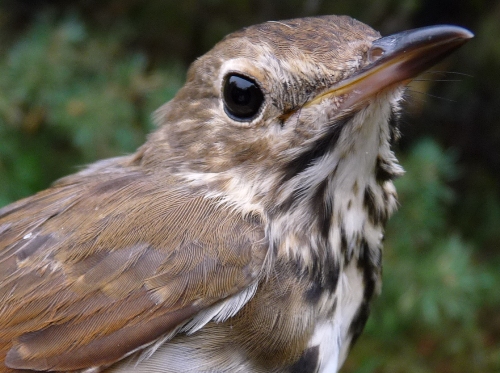
Although typically the most abundant of the Catharus species at MBO, Hermit Thrush is
nonetheless a relatively uncommon migrant, with on average only around 30 individuals
banded
each fall ... but this week we experienced a substantial invasion of them, with
more banded over the past seven days than in any previous entire fall season, and as
many as 16 in a single day. More remarkably still, every single one of them was a
hatch-year bird!
(Photo by Marcel Gahbauer )

|
MBO
gratefully acknowledges the financial support
provided for the 2009 Fall Migration Monitoring
Program by TD Friends of the Environment Foundation
|
|
|
|
THIS WEEK |
THIS FALL |
2009 TOTAL |
SITE TOTAL |
|
# birds (and species) banded |
591 (36) |
2423 (71) |
3427 (82) |
22348 (105) |
|
# birds (and species) repeat |
66 (10) |
445 (34) |
724 (45) |
4071 (66) |
|
# birds (and species) return |
2 (2) |
34 (16) |
152 (32) |
606 (37) |
|
# species observed |
70 |
130 |
162 |
198 |
|
# net hours |
359.5 |
4927.5 |
8286.0 |
38751.3 |
|
# birds banded / 100 net hours |
164.3 |
49.2 |
41.3 |
57.6 |
|
|
Note: table does not include nocturnal banding (owls) |
|
Banders-in-charge: Simon Duval, Marcel Gahbauer, Gay Gruner
Assistants: Jean Bacon, Christine Barrie, Jean Beaudreault, Shawn Craik, Jenia Faibusovitch, Nicki Fleming, Barbara Frei, Tiffany Gilchrist, Jennifer Gruner, Audrey Hihasigiwi, Marie-Anne Hudson, Meg Langley, Barbara MacDuff, Shawn McNamee, Mahmoud Moghrabi, Chris Murphy, Marissa Nolan, Lily Soucy, Alex Stone, Alexis Thorbecke,Rodger Titman, Carine Toumas, Matthew Von Bornhoft, Davis Wood
Notes: Back in August, this fall’s weekly reports often commented on the record number of birds we were banding ... and in contrast, most of the September reports pointed out that our numbers for that period were below average. Well, now that we are solidly into October, it appears the pendulum has at least temporarily swung back the other way again. The 588 birds we banded this week represent the third-busiest week in MBO’s history, behind only weeks 9 and 10 from last fall. And this despite losing Friday entirely to rain, and also having Saturday’s efforts severely curtailed by the weather. On four of the five remaining days, we banded over 100 individuals, capped by 166 on Thursday, our busiest day this year. For the season we remain somewhat below average in many categories (cumulative number of species observed and banded, individuals banded, birds banded per 100 net hours), but if the trend from this week carries over at all into week 11, at least some of these may begin to approach the levels more typical of 2005 – 2007.
Three Red-breasted Mergansers seen flying over the site on Wednesday morning were a first sight record for MBO this year, while Fox Sparrow and House Sparrow were recorded for the first time this fall. Fox Sparrow was also banded for the first time this season, as was Northern Parula – a species that normally comes through MBO almost a month earlier, and that we were quite sure we had missed for the year!
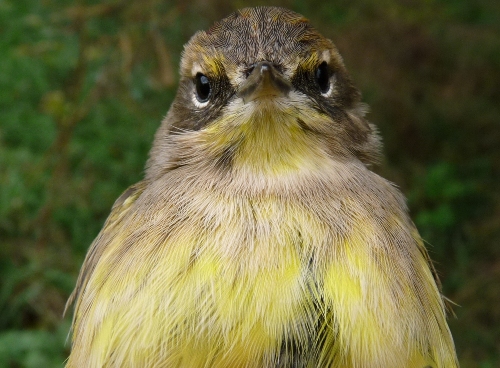
We haven't had a lot of Palm Warblers at MBO this fall, which is disappointing as we are one of the few sites well positioned to get a good mix of the Western and Yellow races on migratoin, and we are eager to work at identifying additional features that might be useful for classifying some of the more intermediate individuals. For the one above though there was no doubt - it is definitely a Yellow Palm Warbler!
(Photos by Marcel Gahbauer)
|
Ruby-crowned Kinglets were by far the species most frequently banded this week, largely on the strength of 77 individuals on Thursday alone, representing nearly half our total catch that day. White-throated Sparrows slipped down to second place this week, but were still abundant. These two species have been in our top three for week 10 every year, so in that sense the current state of migration appears to be quite typical. Although in third place with 70 individuals, Yellow-rumped Warblers are only around 10% as numerous as during the same period last year! At the other extreme, the 46 White-crowned Sparrows banded represent a new single-week record for MBO, and the 37 Hermit Thrushes banded are more in one week than we’ve ever had in an entire season! Rounding out the top 10 for this week, Song Sparrow and Blue-headed Vireo continue their unusually strong showings, while American Robin, Slate-coloured Junco, and Golden-crowned Kinglet numbers are building.
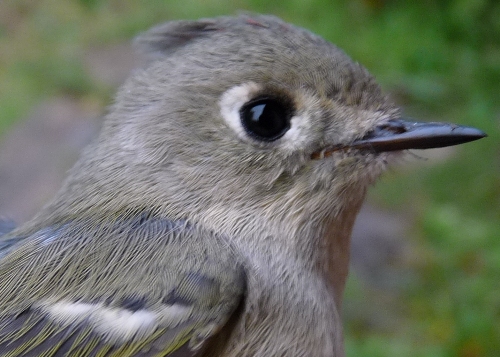
Although the abundance of Ruby-crowned Kinglets this week was not nearly as surprising as the spike in the number of Hermit Thrushes, they were still numerous enough to merit a pictorial highlight in this week's report.
(Photo by Marcel Gahbauer)
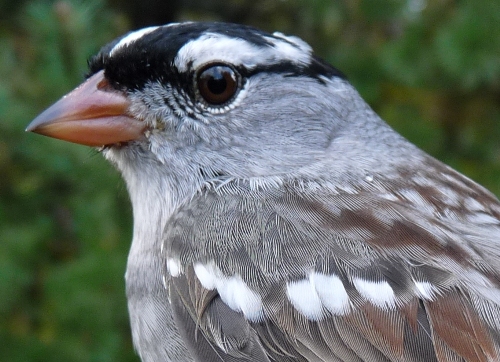
Over the course of MBO's relatively brief history, we have seen a rather steady and substantial increase in the number of White-crowned Sparrows migrating through the site in fall. This year may well prove to be their best yet, with record highs over the past week for numbers observed and banded. Unlike many other species this fall, we're seeing quite a few more adults (like the one above) than hatch-year individuals (like the one below).
(Photos by Marcel Gahbauer)
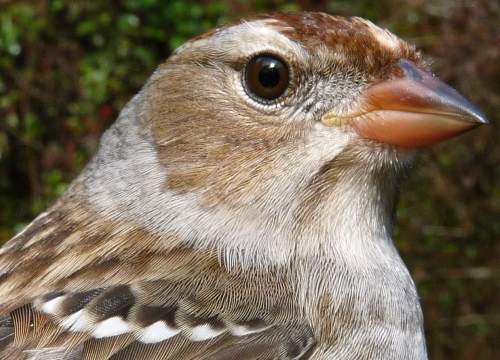
|
With respect to species observed, Canada Goose remains on top for a sixth consecutive week, hardly a surprise given that in all our five fall seasons they have been the most abundant species in both weeks 9 and 10. American Robin numbers seem to be building earlier than usual, while average counts for the week were higher than we’ve ever had before for both White-throated and White-crowned Sparrows – the bushes were just teeming with them day after day! Large mixed flocks of blackbirds were common throughout the week, with European Starling and Red-winged Blackbird most abundant, followed by Common Grackle, but increasing numbers of Rusty Blackbirds as the week progressed. Increases in the number of some of these birds, as well as other early October peak migrants such as Ruby-crowned Kinglet and Yellow-rumped Warbler caused some of our “regulars” to drop off this week’s list, namely Blue Jay, Black-capped Chickadee, Cedar Waxwing, and Song Sparrow.
This week’s top 10 [last week's rank in brackets]
# individuals banded |
mean # individuals observed daily |
1. Ruby-crowned Kinglet (159) [3] |
1. Canada Goose (257.6) [1] |
2. White-throated Sparrow (103) [1] |
2. American Robin (153.9) [3] |
3. Yellow-rumped Warbler (70) [4] |
3. White-throated Sparrow (103.0) [4] |
4. White-crowned Sparrow (46) [6] |
4. European Starling (74.7) [6] |
5. Hermit Thrush (37) [9] |
5. Red-winged Blackbird (60.6) [-] |
6. Song Sparrow (33) [2] |
6. White-crowned Sparrow (42.9) [-] |
7. American Robin (22) [-] |
7. American Crow (40.1) [5] |
8. Slate-coloured Junco (21) [-] |
8. Ruby-crowned Kinglet (37.4) [-] |
9. Blue-headed Vireo (15) [4] |
9. Common Grackle (24.1) [2] |
10. Golden-crowned Kinglet (10) [-] |
10. Yellow-rumped Warbler (24.0) [-] |
|
In closing this week, special thanks to the volunteers who make “big weeks” like this one possible. Even the most experienced, talented, and efficient banders can only handle a certain number of birds in a given time. Without the great help from this week’s extractors, runners, and scribes (sometimes doing double or even triple-duty!), the banders would have been forced to curtail efforts substantially. Just as importantly, censusers and other observers are of especially critical importance during such peak periods, given that the bander(s) and scribe(s) are stuck inside for a much larger part of the morning. The very healthy mean numbers of individuals seen daily are testament to the great job done by this week’s observers. We have another three weeks left in this fall season, and look forward to more great work from the whole team!
|
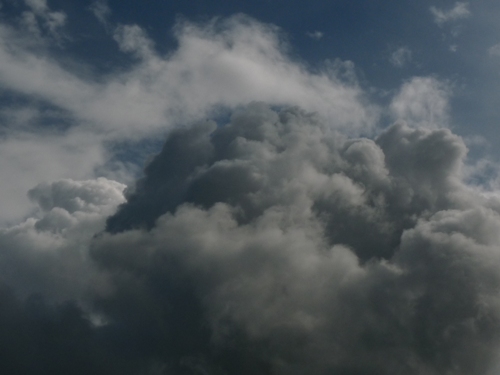
Sometimes the birds aren’t the only memorable elements of a morning at MBO. On Wednesday, the weather was truly bizarre, alternating between sun and rain on several occasions. But when this ominous cloud (above) appeared over the horizon we thought we might be in for something a bit more nasty ... and sure enough, it unleashed a volley of hail (below, on our "release platform") that lasted at least 15 minutes. Fortunately, by that time we had all the nets closed and the remaining birds being banded were kept safely inside until it was safe to release them.
(Photos by Marcel Gahbauer)
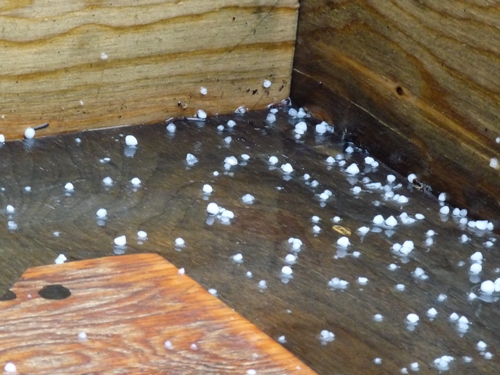

Making up for the nasty weather outside a couple of times this week, we have taken comfort in the warmth and glow of our wood stove!
(Photo by Marcel Gahbauer)
|









